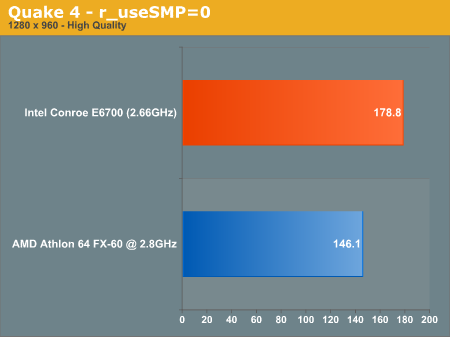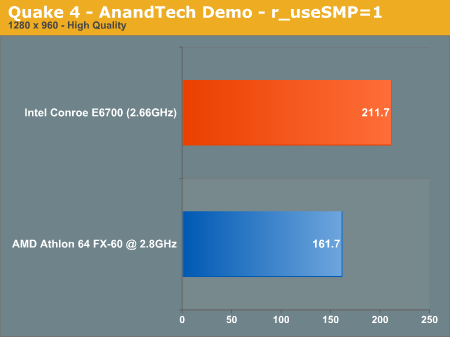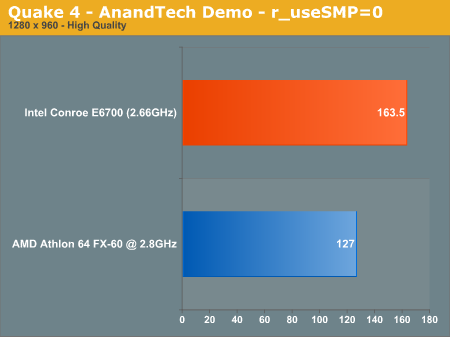Conroe Performance Preview Follow-Up
by Anand Lal Shimpi on March 9, 2006 9:30 AM EST- Posted in
- Trade Shows
The Benchmark Issue
Although we mentioned that there’s not much you can do to make a timedemo really favor one CPU architecture over another, you all demanded that we try with one of our demos. We put our Quake 4 demo file on a USB drive and copied it over to the Conroe and Athlon 64 FX-60 systems that Intel had setup. Note that the version of Quake 4 installed was 1.0.5.0 which is newer than what we test with in our CPU reviews, so you can’t directly compare the numbers to previous AnandTech results but at least we’d be able to see if Intel’s Quake 4 demo was somehow giving Conroe the unfair advantage.
We re-ran Intel’s Quake 4 demo to confirm our initial results. Much to our surprise, we actually short-changed Intel the first time around. We noted that Conroe held a 28% performance advantage over the 2.8GHz Athlon 64 FX-60 with SMP disabled, but with it enabled the performance advantage shrunk to 15%. We re-tested and confirmed our suspicions that Conroe’s Quake 4 performance with SMP enabled was more in line at a 24% advantage:


But what we’re really interested in is how Conroe performed in the very same Quake 4 demo that has been favoring AMD processors in all of our CPU reviews. We loaded up our Quake 4 demo and had at it:


With SMP enabled we see that Conroe holds an even larger 31% performance advantage and with it disabled, the unreleased CPU was 29% faster. If anything, Intel’s own demo was a little more conservative on Conroe and definitely not optimized to make AMD look bad.










96 Comments
View All Comments
Zebo - Thursday, March 9, 2006 - link
No! read about Osborne effect. Essentially this is why new product demos like this, months ahead of schedule, are so rare and NDAs for all products exist.archcommus - Thursday, March 9, 2006 - link
Well good for Intel for coming out with such a strong product, but I'll always have to go with the best bang for the buck, wonder if that'll still end up being AMD even if their parts are weaker across the board this time around.Just hope AMD stays in the game, we can't afford to have the little guy fall behind too much.
samuraiBX - Thursday, March 9, 2006 - link
I've been a diehard amd fan, but kudos to Intel for ramping up competitive products. I have only a couple of additions I'd like to see with the testing:1. I noticed that anandtech used the 2-2-2-5 T1 timings for the RD480 chipset. I remembered from an anandtech review that the best timings for this chipset is 2-2-2-7; not sure how much of a performance difference that would make, but I'd like to see the difference, however slight.
2. I know that this website's impression of the RD480 chipset wasn't stellar, and while I can understand if Intel couldn't purchase the RD580 chipset two weeks ago, I'd imagine it would have been possible to obtain this week, or at least borrow an RD580 board from ASUS; isn't ASUS a participant at IDF this year?
2. I understand that there was limited time, but I would also like to see how the conroe chip would do with 3d studio max. I'm looking to build a high end 3d animation workstation, and I'm looking at the performance leader, whether AMD or Intel.
Wesley Fink - Thursday, March 9, 2006 - link
We did find 2-2-2-7 to provide the best bandwidth in our memory testing on the RD480 chipset, but the difference between 2-2-2-5 and 2-2-2-7 would be less than 1%, and certainly not significant.samuraiBX - Thursday, March 9, 2006 - link
As an addendum:I went to Bit-tech.net; the performance difference by Conroe is awesome! However, it was curious that on their F.E.A.R. benchmarks, the Intel overclocked FX-60 did worse than the reference FX-60.
Accord99 - Thursday, March 9, 2006 - link
Different platform (NF4), different video card (single OC 7800GT). The bit-tech system may have been mored tweaked and perhaps there's some additional overhead in multi-GPU setups like Crossfire which causes reduced performance at extremely low resolutions.HurleyBird - Thursday, March 9, 2006 - link
Did anyone else notice that on the Intel Quake 4 timedemo performance *increased* for both processors but with Anand's timedemo performance *decreased*I wonder why that is?
IntelUser2000 - Thursday, March 9, 2006 - link
You mean on the SMP enabled and disabled benchmarks?? That's because on the page, while SMP disabled(SMP=0) is first on IDF Quake 4, SMP enabled(SMP=1) is next one while on Anand's Quake 4, SMP enabled is first, while SMP disabled is second(skeptics...).
THANKS FOR CONFUSING PEOPLE ANAND, otherwise great article.
MrKaz - Thursday, March 9, 2006 - link
Why Ati drivers where modified to recognize the Conroe processor?What was the problem if the processor didn’t get recognized?
I mean if the FX60 could say Unknown Processor and have no problems, (my mobile 2600+ says the same and runs OK).
What problem would have come from the drivers by not recognizing the processor?
Some drivers optimizations there? Like NVIDIA/ATI?
amano - Thursday, March 9, 2006 - link
Just wondering.. did they use fear.exe, or a renamed fear.exe?Because there seem to be some issues with the fear benchmarking that cripple the AMD:
http://www.beyond3d.com/forum/showthread.php?t=254...">http://www.beyond3d.com/forum/showthread.php?t=254...